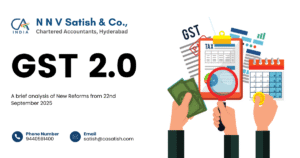Staying compliant with GST regulations is critical for every registered business in India. Failing to meet deadlines or missing key tasks can lead to penalties, interest charges, and unnecessary scrutiny from tax authorities.
This GST compliance checklist simplifies your monthly, quarterly, and annual GST responsibilities—helping you stay organized and penalty-free.
GST compliance isn’t just about filing returns—it’s about maintaining good standing with tax authorities, maximizing input tax credit, and avoiding penalties. Use this checklist to stay ahead of deadlines and ensure your GST filings are accurate and timely.
Monthly GST Compliance Tasks
Most businesses fall under the monthly GST return filing cycle. Here’s what needs to be done every month:1. GSTR-1 Filing
- What it is: Return for outward supplies (sales).
- Who files it: Businesses with turnover above ₹5 crore or those not opted for QRMP scheme.
- Due Date: 11th of every month.
2. GSTR-3B Filing
- What it is: Summary return including outward supplies, input tax credit (ITC), and tax payment.
- Due Date: 20th of every month (varies slightly by state).
3. ITC Reconciliation
- What to do: Match purchase invoices (GSTR-2B) with your accounting records to claim eligible Input Tax Credit.
4. Payment of GST Liability
- Mode: Via electronic cash/credit ledger.
- Tip: Pay before due date to avoid interest @18% per annum on late payments.
Quarterly GST Compliance Tasks
If you’re registered under the QRMP (Quarterly Return Monthly Payment) scheme, here’s what you need to remember:1. GSTR-1 (Quarterly)
- Who qualifies: Businesses with turnover up to ₹5 crore.
- Due Date: 13th of the month following the quarter.
2. GSTR-3B
- Due Dates:
- 22nd of the month following the quarter for Category A states.
- 24th of the month for Category B states.
3. Invoice Furnishing Facility (IFF)
- Optional: File outward supply details for first two months of the quarter.
- Due Date: 13th of the succeeding month.
Annual GST Compliance Tasks
In addition to regular filings, certain annual filings are mandatory depending on your turnover.1. GSTR-9 (Annual Return)
- Who must file: Businesses with turnover above ₹2 crore (mandatory).
- Due Date: 31st December following the end of financial year.
2. GSTR-9C (Reconciliation Statement)
- Who must file: Businesses with turnover above ₹5 crore.
- Due Date: Same as GSTR-9.
3. Annual ITC Review
- Why: Ensures all eligible credits are claimed and ineligible ones reversed.
- When: At the close of the financial year.
GST Due Dates At a Glance
| Return Type | Frequency | Due Date |
|---|---|---|
| GSTR-1 | Monthly | 11th of next month |
| GSTR-3B | Monthly | 20th of next month |
| GSTR-1 (QRMP) | Quarterly | 13th of next quarter |
| GSTR-3B (QRMP) | Quarterly | 22nd or 24th of next quarter |
| GSTR-9 | Annually | 31st December |
| GSTR-9C | Annually | 31st December |
Pro Tips for Staying Compliant
- Set reminders for each return to avoid late fees.
- Regularly reconcile your books with GSTR-2B.
- Avoid fake invoices—ITC is only available on genuine purchases.
- Keep all GST records (invoices, challans, returns) for a minimum of 6 years.
GST compliance isn’t just about filing returns—it’s about maintaining good standing with tax authorities, maximizing input tax credit, and avoiding penalties. Use this checklist to stay ahead of deadlines and ensure your GST filings are accurate and timely.




